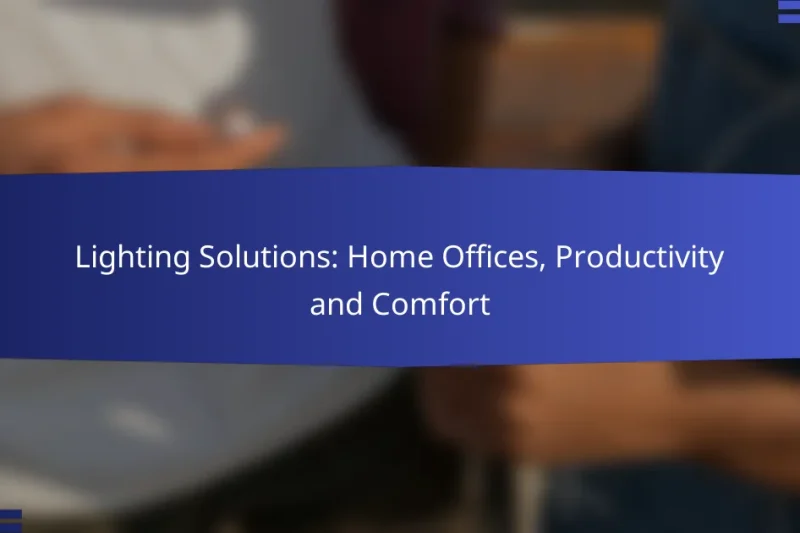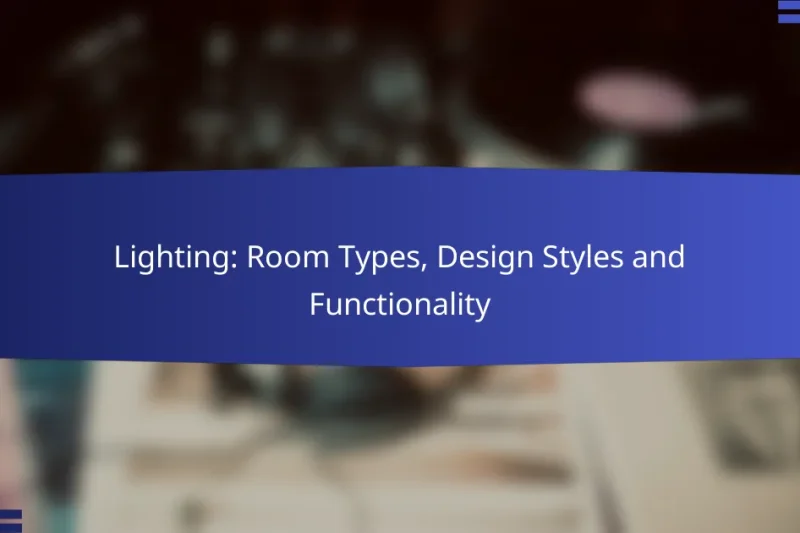When choosing between LED and incandescent bulbs, it’s essential to consider energy efficiency and longevity. LED … LED vs. Incandescent: Which Is Better and When to UseRead more
Lighting Solutions
Lighting solutions play a crucial role in enhancing both the functionality and aesthetics of any space. By incorporating a mix of LED lighting, smart systems, and decorative fixtures, homeowners can create an inviting atmosphere while also promoting energy efficiency. Understanding the specific needs of your room and desired style will help you choose the perfect lighting to illuminate your environment effectively.
Lighting Solutions: Home Offices, Productivity and Comfort
Effective lighting solutions are essential for creating a productive and comfortable home office environment. By incorporating … Lighting Solutions: Home Offices, Productivity and ComfortRead more
Lighting: Room Types, Design Styles and Functionality
Lighting plays a vital role in enhancing the functionality and aesthetic appeal of various room types, … Lighting: Room Types, Design Styles and FunctionalityRead more
Lighting Layering: Techniques, Atmosphere and Ambiance
Lighting layering is a powerful technique that combines various light sources to create an inviting atmosphere … Lighting Layering: Techniques, Atmosphere and AmbianceRead more
Lighting Trends: Modern Styles, Innovations and Aesthetics
In today’s homes, lighting trends emphasize a blend of technology, simplicity, and sustainability, with homeowners increasingly … Lighting Trends: Modern Styles, Innovations and AestheticsRead more
What are the best lighting solutions for homes?
The best lighting solutions for homes include a mix of LED lighting, smart systems, energy-efficient bulbs, decorative fixtures, and task lighting. Each option offers unique benefits, allowing homeowners to enhance functionality and aesthetics while reducing energy consumption.
LED lighting options
LED lighting is one of the most popular choices for home illumination due to its energy efficiency and longevity. These bulbs can last up to 25,000 hours and use up to 80% less energy than traditional incandescent bulbs.
When selecting LED options, consider color temperature, which ranges from warm white (around 2700K) to cool daylight (5000K and above). This allows you to create the desired ambiance in different areas of your home.
Smart lighting systems
Smart lighting systems enable homeowners to control their lights remotely via smartphone apps or voice commands. These systems often allow for scheduling, dimming, and color changes, enhancing convenience and energy savings.
When choosing a smart lighting system, ensure compatibility with your existing home automation devices. Popular options include Philips Hue and LIFX, which offer a variety of bulb types and features.
Energy-efficient bulbs
Energy-efficient bulbs, such as CFLs (compact fluorescent lamps) and LEDs, significantly reduce electricity usage compared to traditional bulbs. They are designed to produce the same amount of light while consuming less power.
When selecting energy-efficient bulbs, look for the ENERGY STAR label, which indicates compliance with strict efficiency guidelines. This can lead to savings on your electricity bill over time.
Decorative fixtures
Decorative fixtures not only provide light but also serve as focal points in your home’s design. Options include chandeliers, pendant lights, and wall sconces, which can enhance the aesthetic appeal of any room.
When choosing decorative fixtures, consider the scale and style of your space. Ensure that the fixture complements your existing decor while providing adequate illumination for the intended area.
Task lighting solutions
Task lighting is essential for specific activities such as reading, cooking, or working. This type of lighting should be bright enough to illuminate the task area without causing glare or shadows.
Common task lighting solutions include desk lamps, under-cabinet lights, and adjustable floor lamps. When selecting task lighting, focus on the brightness (measured in lumens) and color temperature to match the needs of the space.
How to choose the right lighting for my space?
Choosing the right lighting for your space involves understanding the size of the room, the purpose of the lighting, and the desired style. Start by assessing these factors to create a well-lit environment that meets your needs.
Room size considerations
The size of your room significantly impacts your lighting choices. In smaller spaces, opt for fixtures that provide ample light without overwhelming the area, such as flush mounts or wall sconces. Larger rooms may benefit from layered lighting, combining ambient, task, and accent lights to ensure even illumination.
As a general rule, consider the wattage needed based on the room’s square footage. A common guideline is to use about 20 lumens per square foot for general lighting. For example, a 100 square foot room would require around 2,000 lumens.
Lighting purpose and function
Identify the primary function of the lighting to guide your selection. For instance, task lighting is essential in workspaces like kitchens or offices, where focused light is needed for activities such as cooking or reading. Ambient lighting, on the other hand, creates a warm atmosphere for relaxation in living areas.
Consider using dimmers for versatile lighting solutions. They allow you to adjust brightness according to the time of day or activity, enhancing both functionality and comfort.
Style and aesthetics
Your lighting should complement the overall decor of your space. Choose fixtures that align with your interior design style, whether it’s modern, traditional, or eclectic. For example, sleek pendant lights work well in contemporary settings, while ornate chandeliers suit classic interiors.
Don’t forget about the color temperature of the bulbs. Warmer tones (around 2700K) create a cozy feel, while cooler tones (above 4000K) are more energizing and suitable for work areas. Mixing different styles can also add character, but ensure they harmonize to avoid a disjointed look.
What are the benefits of LED lighting?
LED lighting offers numerous advantages, including significant energy savings, longer lifespan, and reduced environmental impact compared to traditional lighting options. These benefits make LEDs a popular choice for both residential and commercial applications.
Energy savings
One of the primary benefits of LED lighting is its energy efficiency. LEDs consume up to 80% less energy than incandescent bulbs, leading to lower electricity bills. For example, replacing a standard 60-watt bulb with a 10-watt LED can result in substantial savings over time.
When considering energy savings, it’s essential to look at the wattage and lumens produced. LEDs provide more light output per watt, which means you can achieve the same brightness with less energy. This efficiency not only saves money but also reduces the load on power grids.
Longevity and durability
LED lights have an impressive lifespan, often lasting 15,000 to 50,000 hours, compared to just 1,000 hours for incandescent bulbs. This longevity means fewer replacements and less waste, making them a cost-effective solution in the long run.
In addition to their long lifespan, LEDs are more durable than traditional bulbs. They are constructed with solid materials, making them resistant to shock, vibrations, and extreme temperatures. This durability is particularly beneficial in commercial settings where lighting is subject to wear and tear.
Environmental impact
LED lighting has a significantly lower environmental impact than conventional lighting options. Their energy efficiency reduces greenhouse gas emissions, contributing to a smaller carbon footprint. By switching to LEDs, households and businesses can play a part in combating climate change.
Moreover, LEDs contain no hazardous materials like mercury, which is found in fluorescent bulbs. This makes their disposal safer and more environmentally friendly. Many regions have regulations encouraging the adoption of LED technology to promote sustainability.
How do smart lighting systems work?
Smart lighting systems operate through the use of connected devices that allow users to control their lights remotely via smartphones or voice commands. These systems typically utilize Wi-Fi or Bluetooth technology to enable communication between the lights and a central hub or app.
Remote control features
Remote control features in smart lighting systems allow users to turn lights on or off, adjust brightness, and change colors from anywhere using a mobile app. Many systems also support voice commands through virtual assistants like Amazon Alexa or Google Assistant, providing hands-free operation.
Some smart lighting solutions include geofencing capabilities, which can automatically turn lights on or off based on the user’s location. This feature enhances convenience and energy efficiency by ensuring lights are only active when needed.
Integration with home automation
Smart lighting systems can seamlessly integrate with other home automation devices, creating a cohesive smart home environment. This integration allows for synchronized actions, such as dimming lights when a home theater system is activated or turning on lights when a security camera detects motion.
Compatibility with platforms like Apple HomeKit, Samsung SmartThings, or Zigbee ensures that users can manage their lighting alongside other smart devices. This interconnectedness enhances user experience and simplifies control through a single interface.
Customization and scheduling
Customization options in smart lighting systems enable users to create personalized lighting scenes for different activities, such as reading, working, or entertaining. Users can adjust color temperatures and brightness levels to suit their preferences and enhance the ambiance of their spaces.
Scheduling features allow users to set specific times for lights to turn on or off, which can help with energy savings and security. For instance, lights can be programmed to simulate occupancy while homeowners are away, deterring potential intruders.
What are the key factors in lighting design?
Key factors in lighting design include layering light sources, selecting appropriate color temperatures, and strategic placement of fixtures. Each of these elements contributes to creating a functional and aesthetically pleasing environment.
Layering light sources
Layering light sources involves combining ambient, task, and accent lighting to achieve a balanced illumination. Ambient lighting provides overall brightness, task lighting focuses on specific activities, and accent lighting highlights features or artwork. This approach enhances the versatility of a space.
For instance, in a living room, use ceiling fixtures for ambient light, table lamps for task lighting, and wall sconces to accentuate artwork. Aim for a mix of light types to create depth and interest.
Color temperature selection
Color temperature selection is crucial for setting the mood and functionality of a space. Measured in Kelvin (K), lower temperatures (around 2700K to 3000K) create a warm, cozy atmosphere, while higher temperatures (4000K to 5000K) produce a cooler, more energizing effect. Choose based on the room’s purpose.
For example, warm light is ideal for bedrooms and living areas, while cooler light works well in kitchens and offices. Consider using dimmable bulbs to adjust the color temperature as needed.
Lighting placement strategies
Effective lighting placement strategies ensure that light is distributed evenly and serves its intended purpose. Position fixtures to minimize shadows and glare, and consider the height and angle of lights. For general lighting, fixtures should be placed to cover the entire area without leaving dark spots.
In task areas, such as a kitchen countertop, place lights directly above the workspace to provide focused illumination. Avoid placing lights too high, as this can reduce effectiveness. Regularly assess and adjust placements to maintain optimal lighting conditions.
What are the latest trends in lighting solutions?
The latest trends in lighting solutions focus on energy efficiency, smart technology integration, and sustainable materials. Innovations such as LED advancements and smart home compatibility are reshaping how we illuminate spaces, making them more adaptable and environmentally friendly.
Energy-efficient lighting options
Energy-efficient lighting options primarily include LED and CFL bulbs, which consume significantly less electricity compared to traditional incandescent bulbs. LEDs can last up to 25,000 hours, while CFLs typically last around 10,000 hours, making them cost-effective in the long run.
When selecting energy-efficient lighting, consider the lumens output rather than watts to gauge brightness. Look for bulbs with the ENERGY STAR label, which ensures they meet strict efficiency standards.
Smart lighting technology
Smart lighting technology allows users to control their lighting remotely through smartphones or voice-activated devices. This technology often includes features like dimming, color changing, and scheduling, enhancing convenience and personalization.
Popular smart lighting systems include Philips Hue and LIFX, which offer a range of bulbs and fixtures compatible with various smart home ecosystems. When choosing smart lighting, ensure compatibility with your existing devices and consider the initial investment versus long-term savings.
Sustainable lighting materials
Sustainable lighting materials focus on reducing environmental impact through the use of recycled or eco-friendly components. Manufacturers are increasingly using materials like bamboo, recycled metals, and biodegradable plastics in their designs.
When selecting sustainable lighting, look for certifications such as LEED or Green Seal, which indicate adherence to environmental standards. Additionally, consider the lifecycle of the product, including its energy consumption and recyclability at the end of its use.




